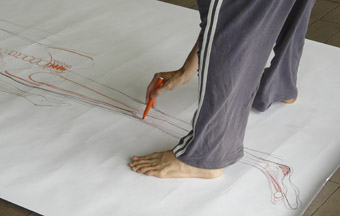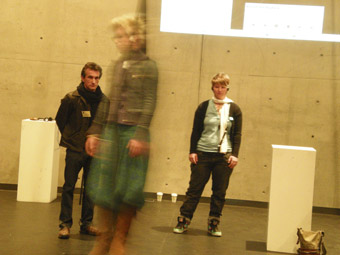the body as lived
mike leggett: thinking through the body

Thinking Through The Body, workshop, Bundanon Trust
photo Catherine Truman
Thinking Through The Body, workshop, Bundanon Trust
THE BODY OBSERVED IS A KEY TO OUR CULTURE. THE BODY AS TEMPLE PERMEATES PARTS OF THAT CULTURE IN WAYS THAT ARE REGARDED WITH CURIOSITY. THE TEMPLE OF KNOWLEDGE IS ANOTHER APPROACH TO THE BODY, UNDERSTANDING OUR EXPERIENCE OF THE WORLD THROUGH REFLECTIVE PRACTICE AND EXPERIMENTATION WITH TOUCH, MOVEMENT AND THE SENSE OF ONE’S POSITION AND VOLUME IN SPACE—PROPRIOCEPTION. THINKING THROUGH THE BODY (TTTB) IS A NSW-BASED INTERDISCIPLINARY RESEARCH PROJECT EXPLORING THE USE AND POTENTIAL OF THE BODY IN INTERACTIVE ART PRACTICES.
While for the past five decades research around the potential of the body in contemporary culture has developed exponentially, from philosophy and sociology, to contemporary arts, healthcare and human-computer interaction design, including haptic displays, bio-metrics, robotics etc, the lived experience of the body-as-subject has remained largely unexamined.
The project began over two years ago in response to the Australia Council for the Arts Inter-Arts Office ArtLab 2008 initiative, that set out to fund up to $75,000 development projects “with an artistic process that demands a very high degree of risk-taking from all involved.” Artists would be expected to experiment with “radical creative processes and be flexible to outcomes that cannot be predicted in advance.” The industry partners with TTTB in this process included Campbelltown Arts Centre, Bundanon Trust and Performance Space, who provided quite different spaces in which the work could proceed.
Without a doubt all the parties involved took risks, launching into unknown territories both as individuals, groups and organisations; no neat outcome could be assuredly predicted. TTTB demonstrated the need for focused research applied to interdisciplinary practice—many of us often seek material contexts for achieving this—but how are we now situated using the knowledge gained through the series of events pursued by this group of collaborators?
One of the project’s initiators, Lizzie Muller, framed some initial conclusions about what has happened as “an experiment in exchanging knowledge and also an experiment in making.” As a curator and recent researcher in the area of interactive media arts, she had previously worked with George Khut on the Cardiomorphologies project through the Creativity & Cognition Studios at UTS and Beta_space at the Powerhouse Museum (RT72, p10). Carefully developed approaches to observing and understanding audience experience of the bio-feedback gained through interaction with the Cardiomorphologies installation led Khut towards recognising the need “to spend some time thinking about connections that I was very interested in between interactive art and somatic bodywork practice. The practice is essentially about a way of re-experiencing the organisation of yourself—of your muscles and skeleton and the movement patterns that you’ve learnt through your life from infancy…Comparable forms of somatic bodywork might be the Feldenkrais Method, the Alexander Technique, things like Body-Mind Centering from Bonnie Bainbridge Cohen…”
The eight TTTB collaborators included Catherine Truman, an artist and certified Feldenkrais practitioner and another Adelaide-based trainer in the discipline, Maggie Slattery; Jonathan Duckworth, artist and interaction designer from Melbourne; Garth Paine artist and academic researcher at the University of Western Sydney’s VIPRe Studios; Lian Loke, artist and Interaction researcher at UTS Human Centred Technology Design group; and media artist and writer Somaya Langley.
Initially, when the group assembled at Campbelltown for the first residency in mid-2008, the differences for Slattery were palpable: “I’ll never forget the first time we had a meeting and everybody but me sat with a laptop on their lap; and I felt naked because I didn’t have a belly that was a screen where I could play my work…The emergence of interactive art began to make sense to me, as somebody outside of a generation who has grown up with technology. One of the things I picked up on was where the word interface is about a relational point between technology and self”, a difference amplified later by Langley: “most of the work that I do is in front of a laptop, so my brain’s out there, the laptop’s my entire interface to what I’m doing.”
Reflections about the initial shared space continued on the TTTB website leading on to the residency six months later at the Bundanon Trust on the Shoalhaven River in rural NSW. Muller observes that, “we were all abducted by aliens, which sounds extreme, but as a metaphor for what an intense experience we’d had it conveys a sense of it to other people.” The Feldenkrais practitioners took a lead, with Truman working through a series of awareness-through-movement lessons interspersed with workshops based on drawing the body; then moulding the body from clay, repeated both sighted and unsighted. “I’m finding each person in this workshop through my philosophy, I guess, and I’m trying to say, what is it you’re asking in your work? Or what is it that interests you? I think it’s really that simple. Rather than what’s out here, what does this technology do, I’m just trying to get people to—and it’s a question I ask myself, it’s my learning, my questions, things I need to know—why is it so important that I need to ask this of somebody else?”
For Khut the outcomes from Bundanon were about establishing a shared language and working through questions as they arose. “So we’re not making art from Feldenkrais or making Feldenkrais from art, it was something else, an understanding. It was about trying to identify these shared approaches and shared sets of questions that these two areas had and how they could enrich each other…[W]e had a session where we brought in some different interactive systems that made sounds from movement or light, or you would hear things in relation to a landscape and we were able to reflect on that in combination with the two workshops that Catherine [Truman] did; and then the workshop that Jonathan [Duckworth] did, which was about being in the landscape and how that connects to an experience of embodiment.“

participant in pendulum piece, Jonathan Duckworth, Sensorium Gymnasium, Performance Space
photo Alejandra Mery Keitel
participant in pendulum piece, Jonathan Duckworth, Sensorium Gymnasium, Performance Space
Duckworth works professionally with patients who have suffered traumatic brain injury and as a result their body self-image is fragmented, resulting in difficulty moving and coordinating a number of motor functions. “So this workshop has helped me realise that the sensing required to become aware of your own body was in much finer detail than the way that I’d been exploring previously.”
At Sensorium Gymnasium, a day-long opportunity for visitors to engage with TTTB’s experiments, Garth Paine’s installation was constructed to demonstrate some provisional conclusions: “I’ve been recording motion capture data [gathered from] subtle Feldenkrais manipulation and it does have incredibly fine nuance which is something I can take away and continue to work with and share…I’m sonifying data at the moment and might also generate some visualisations. So there could be an experiential space that becomes a real-time sonification and visualisation of motion capture data in the space.”
Lian Loke’s understanding of the body comes from dance. The design approach to working with motion-sensing technologies has encouraged her to map relationships between the languages and vocabularies of other disciplines for her use as a designer, to negotiate the different perspectives afforded. The experience has been “about skilling up in that way so I can actually come from a more established foundation myself when designing things.”
Lizzie Muller in describing the “profound gift” of the experience concludes that, “Working in this way with these people has helped me to understand what it is that draws me to art. It is to do with the way it transforms our ability to understand the world.” George Khut has concluded “what motivates me is a desire to create systems and situations that support us to become more alive to the worlds around us and within us; and to be able to experience and engage with this aliveness with a sense of grace, delight and care.”
Thinking Through The Body: Campbelltown Arts Centre, Bundanon Trust, Performance Space, http://thinkingthroughthebody.net/; Sensorium Gymnasium, Performance Space, CarriageWorks, Sydney, Aug 3
RealTime issue #93 Oct-Nov 2009 pg. 31






